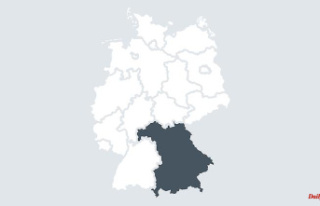While high temperatures have recently made people in Bavaria slow down, the bark beetle really got going. More heat means more offspring - and a spread of the plague for forest owners, even in previously largely problem-free regions.
Freising/Kaufbeuren (dpa/lby) - The hot summer in Bavaria fuels the proliferation of the bark beetle in the forests of the Free State. "We again have a very rapid, temperature-driven development of the bark beetle," said Andreas Hahn, who is responsible for forest protection at the State Institute for Forestry and Forestry. In previous years, the beetles would have reproduced even faster only in 2018.
This makes it more likely that the beetles will create a third brood - which in turn means significantly more damage in the fall and more animals in the coming year, said Hahn. Forest owners must therefore ensure that infested wood is removed from the forest particularly quickly. If that is not possible, insecticides would have to be used if necessary to combat the pest.
Bark beetles bore through the bark to lay eggs, and the larvae also dig holes. Trees weakened by drought can die off in a short time if there is a massive infestation.
The north-east of Franconia is particularly affected. Many spruce trees grow there, which have been weakened by the drought and are therefore easy prey, especially for the bark beetle species Buchdrucker. "We have all the people available to prevent the beetle from spreading," said Fritz Maier, head of the Nordhalben forestry operation (Kronach district). "But we are facing a mass proliferation of the bark beetle that has not existed in living memory."
In the Allgäu, the infestation is not nearly as big. But the beetles had also spread to higher regions where they had previously hardly caused any damage, said Luitpold Titzler, deputy head of the forest department at the Kaufbeuren Office for Food, Agriculture and Forestry. In the Alps, however, spruces are used, among other things, for avalanche protection.
Forest owners would therefore have to keep an eye out for infested trees, which can be identified, among other things, by brown drill dust that has fallen down. Once a week checks are useful, said the State Institute for Forestry and Forestry.
Inspections also take place regularly in the Bavarian Forest National Park, as reported by the head of the department, Franz Baierl. However, this is only relevant in a 500 meter wide edge strip of the national park. The bark beetle can "let off steam" inside.
About 40 percent of the damaged wood is debarked so that the larvae and beetles are destroyed, the rest of the tree then remains in the forest. Such dead wood forms a habitat for other beetles or fungi. The remaining damaged wood is completely removed from the national park and sold to sawmills.
In view of the spread of the bark beetle, the price of wood is falling from month to month, said Baierl. The economic aspect is less important for the national park than for private and state forests. However, higher costs were also incurred due to the additional forestry work.
The spread is enormous this year, says Baierl. In the whole of 2021, the national park recorded around 33,000 cubic meters of damaged wood. This year it has already been 45,000 cubic meters. The trees - spruces in particular are affected - are already weakened by the drought, and so they have little defense against the bark beetle or book printer.












